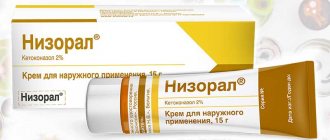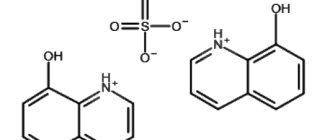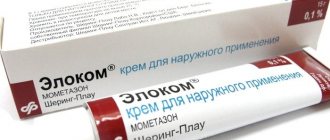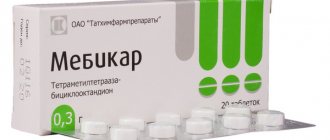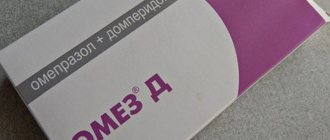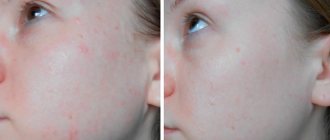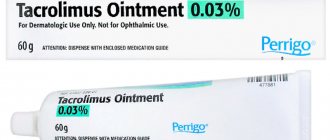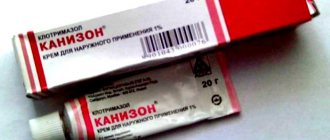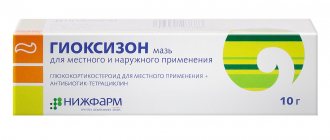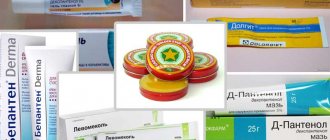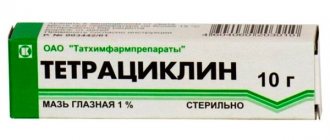Composition and release form
Elokom®
| Cream | 1 g |
| mometasone furoate | 1 mg |
| excipients: hexylene glycol; phosphoric acid; propylene glycol stearate; stearyl alcohol; cetyl stearyl ether; ceteareth-20; titanium dioxide; aluminum octenyl succinate, obtained from starch; white wax; white Vaseline; purified water |
in tubes of 15 g; 1 tube in a cardboard box.
| Ointment | 1 g |
| mometasone furoate | 1 mg |
| excipients: hexylene glycol; phosphoric acid; propylene glycol stearate; white wax; white Vaseline; purified water |
in tubes of 15 g; 1 tube in a cardboard box.
| Lotion | 1 ml |
| mometasone furoate | 1 mg |
| excipients: 40% isopropyl alcohol; propylene glycol; hydroxypropylcellulose; sodium phosphate; water. May also contain phosphoric acid and sodium hydroxide to establish a pH value of approximately 4.5 |
in bottles of 20 ml; 1 bottle in a cardboard box.
Elocom® Lotion
| Lotion | 1 ml |
| mometasone furoate | 1 mg |
| excipients: 40% isopropyl alcohol; propylene glycol; hydroxypropylcellulose; sodium dihydrogen phosphate dihydrate; purified water; phosphoric acid or sodium hydroxide (to establish a pH value of approximately 3.5–5.5) |
PE dropper bottles of 20 ml; 1 bottle in a cardboard box.
pharmachologic effect
Pharmacological action - antiexudative, antipruritic, anti-inflammatory.
The mechanism of action appears to involve inducing the release of proteins that inhibit phospholipase A2 and are collectively known as lipocortins. These proteins are thought to control the biosynthesis of potent inflammatory mediators such as PG and LT by inhibiting the release of their common precursor, arachidonic acid.
Carcinogenesis, mutagenesis. Genetic toxicity studies of mometasone furoate, including the Ames test, the murine lymphoma test, and the micronucleus test, showed no evidence of mutagenicity.
Long-term animal experiments aimed at assessing the carcinogenic effect of the drug have not been conducted.
Price
The cost of the drug depends on the form of release. For example, the cheapest lotion is Elokom. Its price averages two hundred thirty-four rubles. This is one of the reasons why this particular form of release is most popular.
Information for those who prefer Elokom cream: the price of the drug is on average three hundred and eighty rubles. The cost of the ointment is the same.
The drug "Elocom" is a drug that helps to effectively cope with a variety of symptoms of skin diseases in a relatively short time. Available in three forms: ointment, lotion and cream. They differ in structure and ease of application. Each consumer can choose a convenient use case and apply it. The effectiveness of the drug does not change depending on the form of release. Together with the drug "Elokom", the fight against skin diseases will forever cease to seem like an insurmountable task.
Pay due attention to choosing quality medications for yourself and your loved ones, do not neglect the need to regularly consult with an experienced doctor, and study all the available information about the chosen treatment method. This will help you make a decision that you won't regret later. Take care of your well-being and the well-being of your family. And always be healthy!
Pharmacokinetics
The extent to which topical glucocorticosteroids penetrate the skin depends on many factors, including the composition of the drug and the integrity of the epidermal barrier. Inflammation and other processes occurring in the skin can lead to increased penetration of the drug through the skin. With a single local application to intact skin (without an occlusive dressing), approximately 0.7% of the ointment dose and approximately 0.4% of the cream are detected in the blood after 8 hours. There is reason to believe that the level of absorption of the glucocorticosteroid in the dosage form of the lotion is also insignificant.
What is alopecia
Alopecia is a hair pathology characterized by hair loss. Unlike natural loss, they begin to grow in bunches, in large quantities. There are many reasons for this condition, so it is necessary to be examined before starting treatment.
The most difficult thing to get rid of is alopecia areata. This is the most common form of baldness in young men and women. It is associated with autoimmune processes and diseases of the endocrine glands. Therefore, the treatment of such baldness must be comprehensive. Doctors often prescribe hormonal medications. Elokom lotion is considered one of the most effective.
Use during pregnancy and breastfeeding
There have been no adequate, well-controlled studies of the teratogenic potential of mometasone furoate when used during pregnancy. The use of Elokom cream, ointment or lotion during pregnancy is possible only if the expected benefits of treatment for the mother outweigh the potential risk to the fetus.
When used systemically, glucocorticosteroids appear in breast milk, which can lead to slower growth of the child, an impact on the endogenous synthesis of glucocorticosteroids and other adverse effects. There is no evidence that systemic absorption of glucocorticosteroids when applied topically can lead to the appearance of detectable amounts in breast milk. However, due to the fact that many drugs are excreted in breast milk, nursing women should use Elokom cream, ointment, and lotion with caution.
Interactions of the drug Elocom-s
As a result of topical use of Elokom-S, absorption of a very small but detectable amount of salicylates in the blood plasma was noted. A review of the literature on the interaction of salicylates with other drugs after oral administration or application to the skin revealed that the effect of drugs such as tolbutamide, methotrexate, heparin, pyrazinamide, uricosuric agents and coumarin-type drugs may be altered. Other corticosteroids and ammonium sulfate may affect the content of salicylic acid. These interactions should be taken into account when prescribing Elokom-S in combination with these drugs.
Side effects
Cream. In controlled clinical studies on 319 patients, the incidence of adverse events associated with the use of Elokom cream was 1.6%. Burning, itching, skin atrophy were noted; There have been reports of rosacea. In controlled clinical studies in children aged 2 to 12 years (n=74), the incidence of adverse events (burning, itching, furunculosis) associated with the use of the cream was approximately 7%.
Ointment. In controlled clinical studies on 812 patients, the incidence of adverse events associated with the use of Elokom ointment was 4.8%. Burning, tingling, itching, skin atrophy, furunculosis were noted; There have been reports of rosacea. In controlled clinical studies in children aged 2 to 12 years (n=74), the incidence of adverse events (burning, itching, furunculosis) associated with the use of the ointment was approximately 7%.
Lotion. In clinical studies on 209 patients, the following adverse events were noted: burning (4 cases), acne (2 cases), itching (1 case). In a hypersensitivity study of 156 healthy volunteers, folliculitis occurred (4 cases).
With topical use of glucocorticosteroid drugs, the following adverse events may rarely occur in descending order of frequency: skin irritation and dryness, folliculitis, hypertrichosis, acne, hypopigmentation, perioral dermatitis, allergic contact dermatitis, skin maceration, secondary infection, stretch marks and miliaria. The likelihood of these adverse events occurring increases with the use of occlusive dressings.
Contraindications
There are certain conditions that may preclude treatment with the drug in question. Among them are individual intolerance to salicylic acid, mometasone furoate or any other component of this drug, syphilis, herpes simplex, pyoderma, chickenpox, tuberculosis, warts, herpes zoster, parasitic skin diseases, fungal infections (including yeast and dermatophytes), contagious molluscum, genital warts, skin atrophy, rosacea, perioral dermatitis, post-vaccination infections, acne vulgaris. If the patient suffers from one of the diseases listed above, the instructions for use strictly prohibit the use of Elokom (lotion). This should be given special attention.
Directions for use and doses
Locally.
Elokom®
Apply a thin layer of cream or ointment to the affected areas of the skin once a day.
Lotion - apply a few drops to the affected areas of the skin once a day; After application, the lotion is rubbed in with gentle movements until it disappears from the surface of the skin. For the most effective and economical use of the drug, it is necessary to bring the spout of the bottle closer to the affected area of the skin and lightly squeeze the bottle.
Elocom® Lotion
Lotion - apply a few drops to the affected areas of the skin once a day; After application, the lotion is rubbed in with gentle movements until it disappears from the surface of the skin. For the most effective and economical use of the drug, it is necessary to bring the spout of the bottle closer to the affected area of the skin and lightly squeeze the bottle.
The duration of treatment is determined by its effectiveness, as well as patient tolerability, the presence and severity of side effects.
Reviews
Many people leave their feedback about the drug “Elocom” (lotion). Reviews for psoriasis confirm its incredible effectiveness in combating this serious problem. Most buyers report positive results and symptom relief after the first use. Significant improvements become noticeable after just a few days of regular use of the drug. Some customers claim that they have developed an allergy to the drug in question. This shows that the need to consult with your doctor before choosing a drug to combat a disease cannot be ignored.
Still unsure whether you should use Elokom (lotion) in treatment? Reviews show the real effectiveness of the drug. But it would be wise to learn more about its features. We will talk about this further.
Precautionary measures
Elokom cream, ointment, lotion are indicated only for dermatological use and are not intended for use in ophthalmology.
As a result of systemic absorption with local use of various glucocorticosteroid drugs, reversible suppression of the function of the hypothalamic-pituitary-adrenal system, as well as symptoms of glucocorticosteroid insufficiency after discontinuation of the drug, may occur. In patients, as a result of systemic absorption of glucocorticosteroids during systemic use, Cushing's syndrome, hyperglycemia and glycosuria may also develop.
Patients receiving topical corticosteroids for the treatment of large areas of skin or under occlusive dressings should be periodically monitored for signs of suppression of the hypothalamic-pituitary-adrenal axis. This can be done by performing an ACTH stimulation test, measuring morning cortisol in plasma and in media other than urine. If suppression of the hypothalamic-pituitary-adrenal system is noted, the interval between applications should be increased, or another less potent glucocorticosteroid should be used, or the drug should be discontinued. Restoration of the function of the hypothalamic-pituitary-adrenal system usually occurs soon after discontinuation of local glucocorticosteroids. Sometimes signs and symptoms of glucocorticosteroid deficiency may appear, which requires additional use of systemic glucocorticosteroids, a description of which can be found in the annotations for such drugs.
The drug Elokom can be used in children from 2 years of age, however, it should be borne in mind that the safety and effectiveness of its use in children for a period exceeding 3 weeks have not been studied.
Due to the fact that children have a larger surface area to body weight ratio than adults, children are at greater risk of suppressing the function of the hypothalamic-pituitary-adrenal axis and the occurrence of Cushing's syndrome when using any topical glucocorticosteroid drugs. For the same reason, children have a higher risk of adrenal insufficiency when treatment with topical glucocorticosteroids is discontinued. When treated with local glucocorticosteroids in children, atrophic changes in the skin occur more easily, up to the appearance of atrophic stripes. The risk of suppression of the hypothalamic-pituitary-adrenal system in children increases when glucocorticosteroids are applied to an area of more than 20% of the body surface.
There are reports of suppression of the function of the hypothalamic-pituitary-adrenal system, the appearance of Cushing's syndrome, growth retardation, delayed weight gain and intracranial hypertension in children with topical use of various glucocorticosteroid drugs. Manifestations of adrenal insufficiency include low plasma cortisol and lack of response to ACTH stimulation. Intracranial hypertension leads to bulging fontanelles, headache, and bilateral papilledema.
Elokom ointment and cream should not be used to treat dermatitis caused by wearing diapers.
Ointment, cream and lotion should not be used under occlusive dressings unless prescribed by a doctor. Ointment and cream should not be applied to children on areas of skin that are under diapers or under waterproof underpants (occlusive dressing effect). The ointment and cream are not intended for use on the face or in the groin and armpit areas.
If irritation occurs, use of Elokom should be discontinued and appropriate treatment prescribed. Allergic contact dermatitis with corticosteroids is usually diagnosed by evidence of treatment failure, which should be confirmed by skin testing.
If a concomitant skin infection develops, an appropriate antifungal or antibacterial agent should be used. If a positive response to treatment is not achieved quickly, use of the drug should be suspended until the infection is eliminated.
As with other glucocorticosteroids, use of Elokom cream, ointment and lotion should be discontinued once cured. If there is no improvement within 2 weeks after starting therapy, the diagnosis may need to be clarified.
Overdose of the drug Elocom-s, symptoms and treatment
Excessive or prolonged use of local corticosteroids can cause depression of pituitary-adrenal function, which may cause the development of secondary adrenal insufficiency and the appearance of symptoms of hypercortisolism, including Cushing's syndrome. Treatment. If signs of suppression of the hypothalamic-pituitary-adrenal system appear, you should try to reduce the frequency of application of the drug or stop using it. Appropriate symptomatic treatment is also prescribed. In case of toxicity caused by salicylic acid, use of Elokom-S should be discontinued. Fluids are prescribed to induce diuresis. As necessary, sodium bicarbonate and potassium supplements are prescribed (orally or intravenously).

